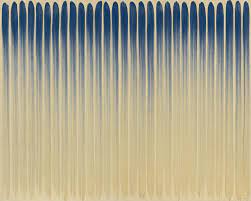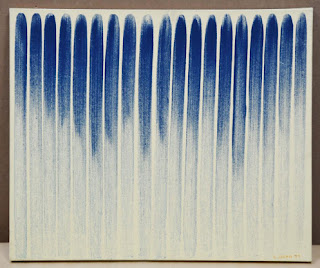THE STRANGEST ART FORGERY OF THE 21ST CENTURY, SO FAR
the Lee Ufan forgeries
By Hae Jeong Cho
 |
| Between a rock and a strange space |
The Lee Ufan art forgery case (2016) is one of the strangest incidents that has ever happened in the history of art. Of course, art forgery is quite a fascinating subject that raises many questions: What is the difference between an original and a forgery? How are they distinguished? And who is the actual victim of a forgery? Is it a crime against the artist or the public or, maybe, merely money? Our concept of art and ownership originates back to the 18th century and on a basic level has come to mean that there is a strong, really, unbreakable connection between a piece of art and the person who creates it. With this idea, the protection of artists’ rights became an important issue and copyright law came to define the work as a product with known authorship and provenance, a fancy art market term for proper ownership.
Unlike music or literary works, paintings are more susceptible to forgeries. Because a painting is singular, it is rare, meaning there is more demand for it and, therefore, more money to be made in the buying and selling of it. But because it is singular, it is also easier to forge. It is sometimes difficult to distinguish forgeries from originals, especially if there are no originals. You‘ll have a hard time forging the Mona Lisa, because we can go to the real one in the Louvre. Where if you forge a so-called unknown work from Leonardo Da Vinci, it will take a little more effort to prove that it isn’t his.
 |
| The Gallery at the center of the storm |
Lee is one of the most renowned Korean artists in the world. In the Korean art market, his paintings are sold at the highest prices at auction. He has had several exhibitions at key worldwide galleries and institutions, including the Guggenheim (2011) and the Palace of Versailles (also 2011). In 2016, Gallery Hyundai bought 13 paintings by Lee at 186 million KRW (approximately 134 million US dollars), which all turned out to be forgeries. The forger admitted it; the courts found him guilty; and the experts in forgeries found them to be forgeries too. It was obvious that the works weren’t original, as in Lee’s. Everything seemed straightforward until Lee took legal action and claimed that they were authentic, his original work. That’s when things got nutty. There’s never quite been a case like it before: the artist who defends the forgeries of his own work.
According to Lee, he painted more than 200 works between 1978 and 1979, and not all were recorded. In this situation, Lee's legal team simply said, "The writer knows when he sees it.” But the prosecution easily and logically pushed back and refuted his claims with scientific evidence. Since then, Lee has said, "There is no forgery,” and "It is difficult to forge because my painting is drawn with my breath.” However, in an interview with Sisa Planning Chang, he took a slightly different stance by saying that when working with a trusted gallery, the gallery might take a leading role in organizing paperwork.
 |
| That's a lot to think about |
In other words, in this interview, he admitted that he could not confirm whether the 13 paintings were genuine or not, and even whether he thought it was right for the Gallery Hyundai to sell these works, supposedly his works. After that, the story becomes unbelievably confusing. It is still being worked out in courts and it’s hard to tell what’s going to happen. All we know is that they are probably not authentic and that for some reason Lee is insisting that they are.
The following are two paintings attributed to Lee: one is a forgery, and the other is an original and they both are from the "Line" series. So, let’s take a look at see what we think:
 |
| FROM THE LINE:THE REAL ONE |
 |
| FROM THE LINE NO. 79039: THE FORGERY |
Lee uses a mixture of lime pigment with a slight bit of minerals and other natural materials for texture. The ingredients are the same, but their use and their effect is slightly off. The counterfeiters get the color right, but the particles in the texture are wrong. There are large particles in the dark colors and thin particles in the bright ones, which is exactly the opposite of Lee’s work. In the case of the original, the beginning of the line does not diverge. However, in the case of the forgery, water condensation is visible at the beginning of the line and the brush paint looks dry overall. The counterfeiters deliberately use old wooden frames to create an antique look, but a glance at the cloth and you can see that they weren’t very good at hiding their work.
And personally, I don't believe it. Lee says he paints the way he breathes, which is a lot. How can such a person paint so many pictures? In a letter to the police, Lee says that he has painted about 100 paintings a year since the late '70s. But in one interview, he said he painted 300 a year. The tripling is unacceptable for all those who think. Again, let's take a look at a "true" Lee and a forged Lee from the "Point" series:
 |
| THE FAKE |
In looking at the two paintings, Lee’s work seems neater and bolder than the forgery. The contrast is sharper, the color of the dots are darker, as if the forgers were overpainting to get the right effect. Lee trains his body and mind to draw a point and it’s not something that you can easily replicate. His actions may seem mechanical or automatic, but that’s the point and that’s hard to fake. Each brushstroke is meant to conserve energy, and you can tell the counterfeiters are just trying to get an effect. It lacks Lee’s elegance and looks unnatural. And that leaves us with one overwhelming question: why is Lee doing this to his legacy? And the only answer that I can think of is a horrible one: money.
If Lee admits that the 13 paintings seized by the police were a forgery, the owners of his work will complain loudly to the gallery concerned. In particular, the credit of Hyundai Gallery, which has handled Lee's works, is bound to be difficult to recover for some time. Looking at Lee's forgery scandal, I think again and again that his work is never something noble that is completed in art. Lee once said in a lecture that his creative method is an expression of rejection of capitalist society represented by mass production and mass consumption. However, how free are Lee Woo-hwan and his works in an extreme capitalist society that accepts money as truth? It is not like that at all. Given that Lee Ufan would claim a work that lacks elegance to be original, do his words have any credibility anymore?
©Hae Jeong Cho and the CCA Arts Review


No comments:
Post a Comment